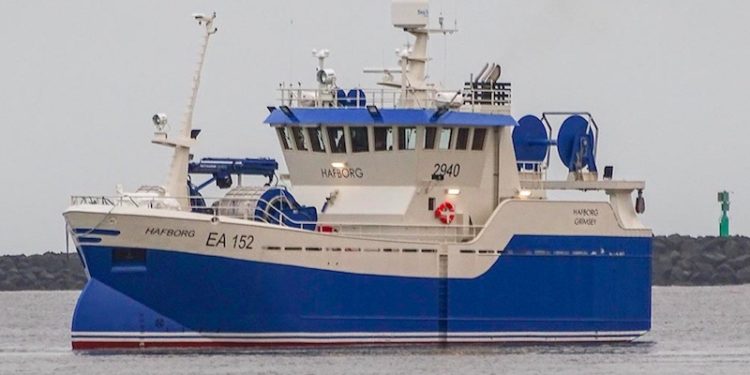It’s more than fifteen years since a new seine netter joined the Icelandic fleet, and the new Hafborg, delivered by the Hvide Sande Shipyard in Denmark, is now on its way home to Iceland.
Hafborg EA-152 is designed by Icelandic naval architect Ráðgarður and completed by Hvide Sande Shipyard on a hull constructed at the Crist yard in Poland, with contracts handled by shipbroker BP Shipping.
The new seine netter/gill netter has been built for skipper Guðlaugur Óli Thorláksson and his son Guðlaugur Óli Guðlaugsson. They are from the island of Grímsey off the north coast of Iceland, although Hafborg is expected to operate largely from the north coast, calling to land at whichever ports are closest to their fishing grounds.
The owners’ requirements were for a vessel capable of alternating seine netting in the summer and into the autumn with gill netting for the rest of the year, and for a high level of comfort and safety for the crew alongside a good carrying capacity in the fishroom and the ability to meet the highest standards of catch quality.
Hafborg measures 25.95 metres overall, with an 8.0 metre beam, with an aluminium superstructure on a steel hull and accommodation on board for a crew of up to eight, although the boat is expected to operate with five.
The layout combined seine netting gear with the seine winches on the forward deck and the net drums and a towing gallows aft, which also provides the option of switching to trawling if the need arises.
The seine netting layout starts with a pair of winches with capacity for 3300 metres of 41mm seine rope and managed by a fly-shooting computer, plus a pair of net drums located at deck level and centrally on top of the aft gallows, all supplied by Thyborøn Skibs & Motor.
The netting setup is on the main deck, with pounds aft for storing gear and a letterbox shooting hatch at the stern, with a pair of hydraulic rams to close it when not in use. Gear is hauled through a hatch on the starboard side, and Hafborg’s net hauler is due to be fitted on arrival in Iceland.
Catches are handled at main deck level, with the fish sorted, gutted and washed in a catch handling system installed by Boa Tech before being transferred to the fishroom below. This has capacity for approximately 50 tonnes of fish in 135 x 600 litre tubs, with a slurry ice installation on board and a holding tank in the fishroom for ice ready to be pumped into the tubs as they fill.
Guðlaugur Óli Guðlaugsson sails as Hafborg’s engineer, and in the spacious engine room he has a Yanmar main engine and a pair of Volvo auxiliaries to manage.
Hafborg’s 837kW Yanmar 6EY17W main engine is coupled to a Mekanord 430-1HS reduction gear with two PTOs and turning the 2100mm controllable pitch propeller at a 4.45:1 reduction ratio. The auxiliaries are 119kWe Volvo Penta D7A TA units, coupled to Stamford UCM 274G generators. The side thruster is a Sleipner SH1400.
Tank capacities on board are for 35 cubic metres of fuel and 14 cubic metres of fresh water.
The wheelhouse is fitted out with a range of electronics, including a JMA-5312 radar, JFC-180BB sounder and JLN-652 doppler current meter, as well as a WAASP multi-beam sounder.
For the full report on Hafborg and interview with skipper and owner Guðlaugur Óli Thorláksson, check out the January edition of Hook and Net









